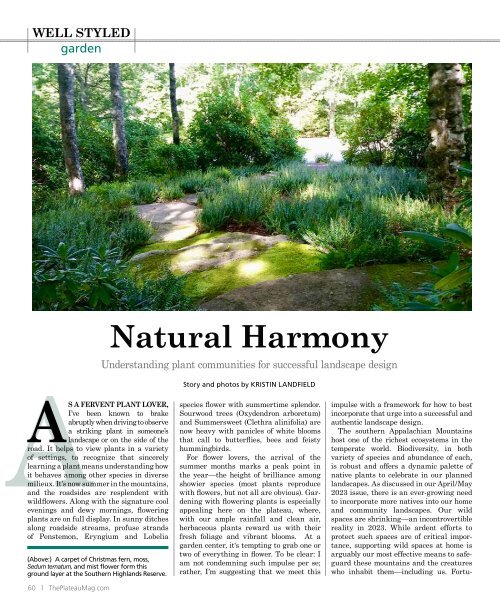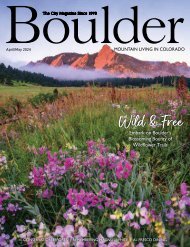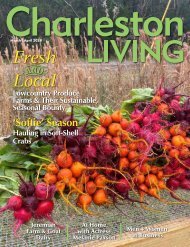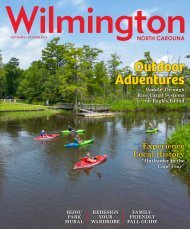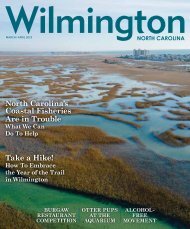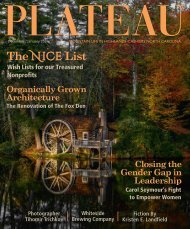Plateau Magazine June-July 2023
This issue we feature women entrepreneurs with locally run businesses and cowgirls who are protecting local animals. We also highlight protecting the land and fields that are important for bees and butterflies pollination. And for the foodies, check out our feature on the Highlands Tavern. Get outdoors with this issue, with our interview on legendary hiker Jennifer Pharr Davis.
This issue we feature women entrepreneurs with locally run businesses and cowgirls who are protecting local animals. We also highlight protecting the land and fields that are important for bees and butterflies pollination. And for the foodies, check out our feature on the Highlands Tavern. Get outdoors with this issue, with our interview on legendary hiker Jennifer Pharr Davis.
Create successful ePaper yourself
Turn your PDF publications into a flip-book with our unique Google optimized e-Paper software.
garden<br />
Natural Harmony<br />
Understanding plant communities for successful landscape design<br />
Story and photos by KRISTIN LANDFIELD<br />
AS A FERVENT PLANT LOVER,<br />
I’ve been known to brake<br />
abruptly when driving to observe<br />
a striking plant in someone’s<br />
landscape or on the side of the<br />
road. It helps to view plants in a variety<br />
of settings, to recognize that sincerely<br />
learning a plant means understanding how<br />
it behaves among other species in diverse<br />
milieux. It’s now summer in the mountains,<br />
and the roadsides are resplendent with<br />
wildflowers. Along with the signature cool<br />
evenings and dewy mornings, flowering<br />
plants are on full display. In sunny ditches<br />
along roadside streams, profuse strands<br />
of Penstemon, Eryngium and Lobelia<br />
(Above:) A carpet of Christmas fern, moss,<br />
Sedum ternatum, and mist flower form this<br />
ground layer at the Southern Highlands Reserve.<br />
60 | The<strong>Plateau</strong>Mag.com<br />
species flower with summertime splendor.<br />
Sourwood trees (Oxydendron arboretum)<br />
and Summersweet (Clethra alinifolia) are<br />
now heavy with panicles of white blooms<br />
that call to butterflies, bees and feisty<br />
hummingbirds.<br />
For flower lovers, the arrival of the<br />
summer months marks a peak point in<br />
the year—the height of brilliance among<br />
showier species (most plants reproduce<br />
with flowers, but not all are obvious). Gardening<br />
with flowering plants is especially<br />
appealing here on the plateau, where,<br />
with our ample rainfall and clean air,<br />
herbaceous plants reward us with their<br />
fresh foliage and vibrant blooms. At a<br />
garden center, it's tempting to grab one or<br />
two of everything in flower. To be clear: I<br />
am not condemning such impulse per se;<br />
rather, I’m suggesting that we meet this<br />
impulse with a framework for how to best<br />
incorporate that urge into a successful and<br />
authentic landscape design.<br />
The southern Appalachian Mountains<br />
host one of the richest ecosystems in the<br />
temperate world. Biodiversity, in both<br />
variety of species and abundance of each,<br />
is robust and offers a dynamic palette of<br />
native plants to celebrate in our planned<br />
landscapes. As discussed in our April/May<br />
<strong>2023</strong> issue, there is an ever-growing need<br />
to incorporate more natives into our home<br />
and community landscapes. Our wild<br />
spaces are shrinking—an incontrovertible<br />
reality in <strong>2023</strong>. While ardent efforts to<br />
protect such spaces are of critical importance,<br />
supporting wild spaces at home is<br />
arguably our most effective means to safeguard<br />
these mountains and the creatures<br />
who inhabit them—including us. Fortu-


